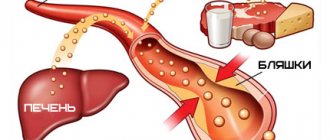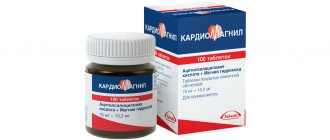With age, due to poor heredity or some other unfavorable third-party factors, patients may develop chronic heart failure, hypertension, coronary heart disease and some other abnormalities in the functioning of the heart and blood vessels.
The listed ailments have pronounced symptoms that cause a person a lot of discomfort, and in some situations are even dangerous to life and health.
A sharp increase in heart rate, headaches, weakness, tremors of the limbs, loss of consciousness and many other unpleasant manifestations of the disease are a consequence of improper functioning of the cardiovascular system. In this case, rapid thinning of the walls of large arteries and wear of the left ventricle of the heart occurs.
In order to eliminate such pronounced symptoms, improve the patient’s general condition and correct the functioning of the cardiovascular system, doctors resort to prescribing special medications, which include Prestarium.
[toc]
Dosage form and composition
Prestarium is produced in the form of tablets for oral use. The active ingredient of the product is perindopril salt. The substance blocks the activity of the enzyme hormone angiotensin, which provokes an increase in blood pressure. The drug has several varieties, differing in dosage and content of auxiliary compounds:
- Prestarium tablets: containing 2, 4 and 8 mg. perindopril;
- Prestarium A: with an increased dosage: 2.5, as well as 5 and 10 mg;
- Bi-Prestarium: tablets in double dosage containing amlodipine, a calcium channel blocker.
All types of Prestarium have a similar effect, but they are prescribed for varying severity of hypertension.
Combination with other medications
Prestarium in combination with some other drugs can lead to an increase in potassium levels in the blood.
This condition can be dangerous not only for the general condition, but also for the life of the patient.
For example, Prestarium and Cardiomagnyl have negative compatibility. But Prestarium and Amlodipine are sometimes prescribed together.
Therefore, it is recommended to inform your doctor about combinations of Prestarium with any other medications. The doctor will not only select a safe dosage, but also, if necessary, select analogues of the previously used medication.
How does Prestarium work?
The drug reduces the production of the hormone aldosterone, the breakdown of bradykinin and renin activity. The decrease in blood pressure as a result of taking it is not accompanied by a disturbance in heart rate. The use of Prestarium has a beneficial effect on renal blood flow. In this case, the main functions of the organs are not affected. During treatment, the size of the enlarged left ventricle is normalized, and the elasticity of the coronary and other large vessels improves. Prestarium containing amlodipine has a complex effect:
- dilates blood vessels;
- normalizes blood flow in the heart vessels and capillaries;
- reduces the load on the myocardium, improves its blood supply.
The medicine does not affect cholesterol metabolism and does not lead to metabolic disorders. The therapeutic effect develops within 1 hour after taking the tablets. It has a cumulative mechanism of action, the maximum is observed on days 4–5 from the start of the course and persists throughout its entire duration. Metabolites of the drug are excreted in the urine. Its remains do not accumulate inside the body. After withdrawal, patients do not exhibit addiction syndrome.
When is Prestarium shown?
The drug alleviates the physical condition of various cardiovascular pathologies:
- hypertension;
- chronic heart failure;
- for coronary heart disease: in stable condition;
- after a transient ischemic attack;
Prestarium can also be prescribed as a prevention of heart attack as part of complex treatment: in combination with other drugs.
Contraindications
Prestarium is prohibited for use in the following pathologies:
- angioedema;
- intolerance to ACE inhibitors;
- galactosemia.
Breastfeeding and pregnancy at all stages are also reasons to exclude the drug from the treatment regimen. The drug should be used with caution in cases of electrolyte imbalance, after internal organ transplantation, aortic valve stenosis, and systemic connective tissue pathologies. Patients on hemodialysis or taking antidepressants should carefully select the dosage and monitor their well-being. Conditions accompanied by excessive vomiting, diarrhea, dehydration, and renal failure also require special attention.
Overdose
Fortunately, at the moment, when taking the drug Prestarium, an overdose has never been officially recorded.
However, if you use a large amount of the drug, some negative manifestations are possible:
- renal failure;
- a pronounced decrease in blood pressure, uncharacteristic for the patient;
- state of shock;
- bradycardia;
- electrolyte imbalance.
If an overdose of the drug does occur, dangerous consequences can be easily prevented by flushing the stomach.
After rinsing, it is recommended to administer intravenous saline. The listed measures will be sufficient to neutralize the harmful effects of the substances contained in the medicine. To avoid overdose and side effects, it is recommended to strictly adhere to the recommendations given by your doctor.
Such serious side effects as heart attack, stroke, acute renal failure, and rhinorrhea are almost never observed when the dose is increased.
Side effects
Prestarium can cause the following undesirable reactions from the body:
- nausea, dry mouth, loss of appetite;
- dry cough;
- increased uric acid levels;
- dizziness, headaches;
- physical weakness, apathy, increased drowsiness;
- depression;
- swelling of the ankles;
- thrombocytopenia, decreased hemoglobin, red blood cells and other blood count disorders.
Allergic reactions may cause skin itching, rashes, swelling of the mucous membranes and skin, and respiratory problems. Men may experience decreased libido. In case of overdose, vascular collapse, bradycardia, and impaired coordination of movements are likely.
Contraindications for use
The drug has certain contraindications for use. Thus, taking Prestarium is strictly prohibited if:
- the presence of an allergic reaction to ACE inhibitors;
- under 18 years of age;
- insufficient production of the enzyme lactase;
- pregnancy;
- breastfeeding period.
It is also undesirable to use the medication in case of renal failure or the presence of only one working kidney, angina pectoris, cerebrovascular diseases, and so on.
How to use Prestarium: instructions
The doctor prescribes the exact treatment regimen depending on the type of disease and the age of the patient. General recommendations:
- The tablets must be taken on an empty stomach, in the morning, with plenty of water; there is no need to chew the drug;
- the prescribed dose is taken once: it can range from 2 to 8 mg per day;
- in acute conditions, the drug is taken no earlier than complete normalization and remission.
For elderly people and other risk groups, the dosage is adjusted downwards. It is prohibited to change the number of tablets on your own. The course of treatment is continued until the physical condition is stabilized and the existing pathologies are normalized. If necessary, Prestarium is taken for several months in a row or continuously. It is allowed to combine it with diuretic medications.
The drug is incompatible with narcotic analgesics, corticosteroid hormones, immunosuppressants, cytostatics, diabetes treatments, antipsychotics, since when taken simultaneously, the risk of side effects mutually increases.
Prestarium®
IHD: reducing the risk of cardiovascular complications in patients who have previously had myocardial infarction and/or coronary revascularization
If unstable angina develops during the first month of therapy with Prestarium®, the benefits and risks should be assessed before continuing therapy.
Arterial hypotension
ACE inhibitors can cause a sharp decrease in blood pressure. Symptomatic arterial hypotension rarely develops in patients without concomitant diseases. The risk of an excessive decrease in blood pressure is increased in patients with reduced blood volume, which can be observed during diuretic therapy, following a strict salt-free diet, hemodialysis, vomiting and diarrhea, as well as in patients with severe arterial hypertension with high plasma renin activity (see sections “Interaction with other drugs” and “Special instructions”).
In most cases, episodes of pronounced decrease in blood pressure are observed in patients with severe chronic heart failure, both in the presence of concomitant renal failure and in its absence. This side effect is most often observed in patients receiving loop diuretics in high doses, as well as in patients with hyponatremia or impaired renal function.
At the beginning of therapy and when increasing the dose of Prestarium®, patients should be under close medical supervision (see sections “Dosage and Administration” and “Side Effects”). A similar approach should be used in patients with angina pectoris and cerebrovascular diseases, in whom severe arterial hypotension can lead to the development of myocardial infarction or cerebrovascular complications.
If there is a significant decrease in blood pressure, the patient should be transferred to the “lying” position on his back with his legs elevated and immediately replenish the blood volume (for example, intravenous infusion of 0.9% sodium chloride solution). Intravenous administration of angiotensin II and/or catecholamines is also possible. A pronounced decrease in blood pressure when taking the drug for the first time is not an obstacle to further use of the drug. After restoration of blood volume and blood pressure, treatment can be continued with careful selection of doses of the drug Prestarium®.
In some patients with chronic heart failure and normal or low blood pressure, Prestarium® may cause an additional decrease in blood pressure. This effect is predictable and does not usually require discontinuation of therapy. If symptoms of a pronounced decrease in blood pressure appear, the dose of the drug should be reduced or discontinued.
Mitral stenosis/aortic stenosis/hypertrophic obstructive cardiomyopathy
Prestarium®, like other ACE inhibitors, should be used with caution in patients with obstruction of the left ventricular outflow tract (aortic stenosis, hypertrophic obstructive cardiomyopathy), as well as in patients with mitral stenosis.
Renal dysfunction
For patients with renal failure (creatinine clearance less than 60 ml/min.), the initial dose of Prestarium® is selected depending on the clearance value (see section “Method of administration and dosage”) and then depending on the therapeutic effect. For such patients, regular monitoring of QC and potassium levels in the blood plasma is necessary (see section “Side Effects”).
Hypotension, which sometimes develops when starting ACE inhibitors in patients with symptomatic chronic heart failure, can lead to deterioration of renal function. Acute renal failure may develop, usually reversible.
In patients with bilateral renal artery stenosis or stenosis of the artery of a single kidney (especially in the presence of renal failure), during therapy with ACE inhibitors, there may be an increase in the concentration of urea and creatinine in the blood plasma, which usually resolves when therapy is discontinued.
The additional presence of renovascular hypertension causes an increased risk of developing severe arterial hypotension and renal failure. Treatment of such patients begins under close medical supervision using low doses of the drug and further adequate selection of doses. Treatment with diuretics should be temporarily discontinued and serum potassium and creatinine levels monitored regularly during the first few weeks of therapy.
In some patients with arterial hypertension, in the presence of previously undetected renal failure, especially with simultaneous use of diuretics, the concentration of urea and creatinine in the blood serum may increase. These changes are usually mild and reversible. In such cases, it may be necessary to discontinue or reduce the dose of Prestarium® and/or diuretic.
Hemodialysis
Several cases of persistent, life-threatening anaphylactic reactions have been reported in patients undergoing hemodialysis using high-flux membranes (eg, AN69®). Prescription of ACE inhibitors should be avoided when using this type of membrane.
Kidney transplantation
There are no data on the use of Prestarium® after kidney transplantation.
Hypersensitivity/angioedema
In patients taking ACE inhibitors, in rare cases, especially during the first few weeks of therapy, angioedema of the face, extremities, lips, tongue, glottis and/or larynx may develop. In rare cases, severe angioedema may occur during prolonged use of an ACE inhibitor. If these symptoms appear, the use of the drug Prestarium® should be stopped immediately, and drugs of another pharmacotherapeutic group should be used as a replacement.
Angioedema, accompanied by swelling of the larynx, can be fatal. Swelling of the tongue, glottis, or larynx can lead to airway obstruction. When it develops, emergency therapy includes, among other prescriptions, immediate subcutaneous administration of a solution of epinephrine (adrenaline) 1:1000 (1 mg/ml) 0.3-0.5 ml or slow intravenous administration (in accordance with the preparation instructions infusion solution) under ECG and blood pressure control. The patient should be hospitalized for treatment and observation for at least 12-24 hours until complete regression of symptoms.
Patients with a history of angioedema not associated with taking ACE inhibitors may have an increased risk of developing it when taking drugs of this group (see section “Contraindications”).
In rare cases, angioedema of the intestine develops during therapy with ACE inhibitors. In this case, patients experience abdominal pain as an isolated symptom or in combination with nausea and vomiting, in some cases without previous angioedema of the face and with normal activity of the C-1 esterase enzyme. The diagnosis is made using computed tomography of the abdominal region, ultrasound, or at the time of surgery. Symptoms disappear after stopping ACE inhibitors. In patients with abdominal pain receiving ACE inhibitors, the possibility of developing angioedema of the intestine must be taken into account when making a differential diagnosis.
Anaphylactic reactions during low-density lipoprotein (LDL) apheresis
In rare cases, life-threatening anaphylactic reactions may occur in patients receiving ACE inhibitors during low-density lipoprotein apheresis with dextran sulfate. To prevent an anaphylactic reaction, ACE inhibitor therapy should be temporarily discontinued before each LDL apheresis procedure using dextran sulfate.
Anaphylactic reactions during desensitization
There are isolated reports of the development of life-threatening anaphylactic reactions in patients receiving ACE inhibitors during desensitizing therapy with bee venom (bees, wasps). ACE inhibitors should be used with caution in patients with a predisposition to allergic reactions undergoing desensitization procedures. The use of ACE inhibitors should be avoided in patients receiving bee venom immunotherapy. However, this reaction can be avoided by temporarily discontinuing the ACE inhibitor before starting the desensitization procedure.
Liver dysfunction
Taking ACE inhibitors is sometimes associated with a syndrome starting with the development of cholestatic jaundice, progressing to fulminant hepatic necrosis, and (sometimes) death. The mechanism of development of this syndrome is unclear. If symptoms of jaundice or increased activity of liver enzymes appear in patients taking ACE inhibitors, drug therapy should be discontinued and appropriate examination should be carried out (see section “Side Effects”).
Neutropenia/agranulocytosis/thrombocytopenia/anemia
During therapy with ACE inhibitors, neutropenia/agranulocytosis, thrombocytopenia and anemia may develop. With normal renal function and the absence of other complications, neutropenia rarely occurs. ACE inhibitors are used only in emergency cases in the presence of systemic vasculitis, immunosuppressive therapy, taking allopurinol or procainamide, as well as when combining all of these factors, especially against the background of previous renal failure. There is a risk of developing severe infectious diseases that are resistant to intensive antibiotic therapy. When carrying out therapy with Prestarium® in patients with the above factors, it is necessary to regularly monitor the leukocyte count.
Ethnic differences
It should be taken into account that patients of the Negroid race have a higher risk of developing angioedema. Like other ACE inhibitors, Prestarium® is less effective in lowering blood pressure in black patients.
This effect may be associated with a pronounced predominance of low-renin status in black patients with arterial hypertension.
Cough
During therapy with an ACE inhibitor, a dry, non-productive cough may occur, which stops after discontinuation of the drug.
Surgery/general anesthesia
The use of ACE inhibitors in patients undergoing surgery under general anesthesia can lead to a significant decrease in blood pressure, especially when using general anesthetic agents that have an antihypertensive effect. Taking Prestarium® should be stopped one day before surgery. If arterial hypotension develops, blood pressure should be maintained by replenishing blood volume.
It is necessary to warn the anesthesiologist that the patient is taking ACE inhibitors.
Hyperkalemia
Hyperkalemia may develop during treatment with ACE inhibitors, especially if the patient has renal and/or heart failure or latent diabetes mellitus. The use of potassium supplements, potassium-sparing diuretics, and other drugs associated with a risk of potassium elevation (eg, heparin) is generally not recommended due to the potential for severe hyperkalemia. If the combined use of these drugs is necessary, then therapy should be accompanied by regular monitoring of potassium levels in the blood serum.
Diabetes
In patients taking oral hypoglycemic agents or insulin, plasma glucose concentrations should be regularly monitored during the first month of therapy with ACE inhibitors (see section “Interaction with other drugs”).
Lithium preparations
The combined use of Prestarium® and lithium preparations is not recommended (see section “Interaction with other drugs”).
Potassium-sparing diuretics, potassium supplements, potassium-containing table salt substitutes and food supplements
Concomitant use with ACE inhibitors is not recommended (see section “Interaction with other drugs”).








